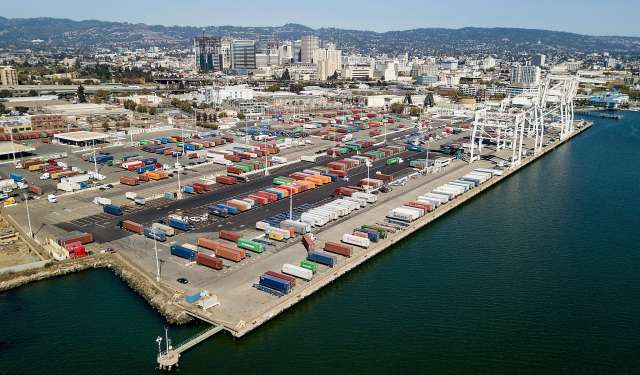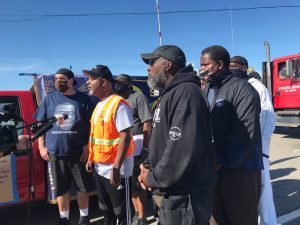Bay Area
Town Hall Says Don’t Let Fisher’s Stadium Project Choke the Port of Oakland
Post publisher Paul Cobb said the newspaper has been discussing the different sides of this issue and hopes to help clear up the confusing messages the public is receiving about whether this project will help or damage the prospects of good jobs for Oaklanders.

A town hall meeting this week examined the negative consequences of placing John Fisher’s privatized, multibillion dollar real estate development on publicly owned land at the Port of Oakland, the region’s thriving and growing economic engine.
More than 100 people attended the town hall on Wednesday, which was live on Zoom and Facebook. Councilmembers Carroll Fife and Noel Gallo were among those who attended.
Speakers included voices of those who are directly impacted by the project: members of the longshore union, the ILWU, who said the project was a dangerous threat to the livelihood of port workers, over 70% of whom are Black; representatives of the Pacific Merchants Shipping Association and several of the largest businesses based at the port; and Paul Cobb, publisher of the Oakland Post.

ILWU Local 10 President Trent Willis, with other union members, speaks on June 19, 2020 about shutting down West Coast ports for Juneteenth. Photo by Workers World, Judy Greenspan.
Though called a baseball stadium project, the massive, luxury real estate development is what backers have called a “city within a city.” Besides a stadium, the plan calls for 3,000 luxury condominiums, with no guaranteed affordable housing; 1.5 million square feet of high-rise office space; a 400-room hotel; retail shopping; and a performance venue with seating for 3,500.
Linda Adams, a member of the ILWU who is who is one of the workers “responsible for moving the cargo on a daily basis,” said, they are “compromising our jobs.”
“They say they can build these high rise luxury condos, and (we) can work around them. But we’re moving cargo around the clock, (with) thousands of (workers), trucks and cargo coming into the port.” She pointed out that luxury tenants will go to court to stop the noise, pollution, bright lights and thousands of daily trucks and railroads that are wrecking their days and nights, pushing companies to leave Oakland for other West Coast ports.
Susan Ransom, representing SSA Marine, the Port’s largest tenant, said the Port has over 84,000 total employees and moves the products on which everyone depends – food, household goods and medical supplies
“We have grave concerns about the A’s (stadium) project,” she said. ”We operate 24/7, (our work) would not be stopped during a game” or for a fireworks display.
Mike Jacob of the Pacific Merchants Shipping Association which represents employers, said, “We have real issue here. Do we want to preserve our industrial base? Do we want to make Oakland a smaller kid’s version of San Francisco? Should Oakland continue to be a blue-collar city with good blue-collar jobs.”
Jacob said he was talking with the A’s, but they stopped meeting with him in 2019 when he raised concerns that would be expensive to mitigate. “You don’t have to be either pro- or anti-baseball to be pro-port,” he said.
ILWU business agent Aaron Wright, broadcasting live from on top of a port crane, showed the basin where ships have to turn around, which would be impacted by the project, and the Howard Terminal property, where thousands of trucks park daily instead of where they parked in the past on West Oakland and other neighborhoods’ residential streets. “One day at the port can do more for the economy than all of the team’s home games,” he said. “You can’t bring in thousands of sports fans to block all of this.”
Andrea Luna Bocanegra, who works for a manufacturing company that does business with the port, said that disrupting shipping at the port would cause a ripple effect, damaging manufacturing businesses throughout Northern California that utilize the port as a dependable way to ship their products and the receive goods they need to run their operations.
Post publisher Paul Cobb said the newspaper has been discussing the different sides of this issue and hopes to help clear up the confusing messages the public is receiving about whether this project will help or damage the prospects of good jobs for Oaklanders.
Cobb displayed an Alameda Labor Council flyer promoting jobs for Blacks. He said “it’s encouraging to see Labor unions join the fight to hire and protect Black workers. By working together with civil rights groups we can finally expand the narrow definitions of PLA’s (project labor agreements) and redefine them as CLA’s (community labor agreements) that will hire Blacks and formerly incarcerated across all trades.”
“We are being lobbied on both sides of this issue,” he said. “Some say Howard Terminal is no longer vital to port operations, but others it very important to the economy” and to keep the port running daily.
A number of people submitted written comments during the Zoom meeting.
Housing rights activists James Vann wrote, “There are innumerable negatives from placing an A’s stadium at Howard Terminal. Can anyone name just one benefit from placing the stadium at this location within the Port?”
BART Director Robert Raburn, wrote, “A significant and unmitigated impact is public safety at the unprotected railroad grade crossings.”
“In addition to BART, I also serve on the governing board for the Capitol Corridor, which operates 30 passenger trains. a day on West Embarcadero (and) another 20 trains deadhead to the Amtrak yard each day,” he said.
“No stadium in the US permits postgame crowds of up to 35,000 to risk crossing mainline railroad tracks at-grade! The costs to mitigate these hazards are not included in the (A’s) ‘term sheet.’”
Organizers of the townhall are asking community members to attend the City Council meeting Tuesday, July 20. The council will consider voting on a non-binding resolution regarding the term sheet for the development. Public comment begins at 9 a.m.
People are encouraged to email council members at https://form.123formbuilder.com/4755450/
The video of Wednesday’s town hall can be watched on Facebook at https://fb.watch/6M9NiSMAxc/
Activism
Oakland Post: Week of May 21 – 27, 2025
The printed Weekly Edition of the Oakland Post: Week of May 21 – 27, 2025

To enlarge your view of this issue, use the slider, magnifying glass icon or full page icon in the lower right corner of the browser window.
Bay Area
Chevron Richmond Installs Baker Hughes Flare.IQ, Real-time Flare Monitoring, Control and Reduction System
While the sight of flaring can cause concern in the community, flares are essential safety systems that burn pollutants to prevent them from being released directly into the atmosphere. They activate during startup and shut-down of facility units or during upsets or equipment malfunctions. The typical flare stack is about 200 feet high so that vapors are well above street levels.

The Richmond Standard
Chevron Richmond recently installed flare.IQ, a real-time, automated system that will improve the facility’s flaring performance.
The technology, developed by Panametrics, a Baker Hughes business, uses sensors to monitor, reduce and control flaring in real time. It collects and assesses data on refinery processes, such as temperature, pressure, gas flow and gas composition, and adjusts accordingly to ensure flares burn more efficiently and cleanly, leading to fewer emissions.
“The cleaner the flare, the brighter the flame can look,” said Duy Nguyen, a Chevron Richmond flaring specialist. “If you see a brighter flame than usual on a flare, that actually means flare.IQ is operating as intended.”
While the sight of flaring can cause concern in the community, flares are essential safety systems that burn pollutants to prevent them from being released directly into the atmosphere. They activate during startup and shut-down of facility units or during upsets or equipment malfunctions. The typical flare stack is about 200 feet high so that vapors are well above street levels.
“A key element in Baker Hughes’ emissions abatement portfolio, flare.IQ has a proven track record in optimizing flare operations and significantly reducing emissions,” said Colin Hehir, vice president of Panametrics, a Baker Hughes business. “By partnering with Chevron Richmond, one of the first operators in North America to adopt flare.IQ, we are looking forward to enhancing the plant’s flaring operations.”
The installation of flare.IQ is part of a broader and ongoing effort by Chevron Richmond to improve flare performance, particularly in response to increased events after the new, more efficient hydrogen plant was brought online in 2019.
Since then, the company has invested $25 million — and counting — into flare minimization. As part of the effort, a multidisciplinary refinery team was formed to find and implement ways to improve operational reliability and ultimately reduce flaring. Operators and other employees involved in management of flares and flare gas recovery systems undergo new training.
“It is important to me that the community knows we are working hard to lower emissions and improve our flaring performance,” Nguyen said.
Also evolving is the process by which community members are notified of flaring incidents. The Community Warning System (CWS), operated by Contra Costa County is an “all-hazard” public warning system.
Residents can opt-in to receive alerts via text, e-mail and landline. The CWS was recently expanded to enable residents to receive notifications for “Level 1” incidents, which are considered informational as they do not require any community action.
For more information related to these topics, check out the resources included on the Chevron Richmond, CAER and Contra Costa Health websites. Residents are also encouraged to follow @chevronrichmond and @RFDCAOnline on Facebook and X (formerly Twitter), where additional information may be posted during an incident.
Activism
Oakland Hosts Town Hall Addressing Lead Hazards in City Housing
According to the city, there are 22,000 households in need of services for lead issues, most in predominantly low-income or Black and Latino neighborhoods, but only 550 to 600 homes are addressed every year. The city is hoping to use part of the multimillion-dollar settlement to increase the number of households served each year.

By Magaly Muñoz
The City of Oakland’s Housing and Community Development Department hosted a town hall in the Fruitvale to discuss the efforts being undertaken to remove lead primarily found in housing in East and West Oakland.
In 2021, the city was awarded $14 million out of a $24 million legal settlement from a lawsuit against paint distributors for selling lead-based paint that has affected hundreds of families in Oakland and Alameda County. The funding is intended to be used for lead poisoning reduction and prevention services in paint only, not water or other sources as has been found recently in schools across the city.
The settlement can be used for developing or enhancing programs that abate lead-based paint, providing services to individuals, particularly exposed children, educating the public about hazards caused by lead paint, and covering attorney’s fees incurred in pursuing litigation.
According to the city, there are 22,000 households in need of services for lead issues, most in predominantly low-income or Black and Latino neighborhoods, but only 550 to 600 homes are addressed every year. The city is hoping to use part of the multimillion-dollar settlement to increase the number of households served each year.
Most of the homes affected were built prior to 1978, and 12,000 of these homes are considered to be at high risk for lead poisoning.
City councilmember Noel Gallo, who represents a few of the lead-affected Census tracts, said the majority of the poisoned kids and families are coming directly from neighborhoods like the Fruitvale.
“When you look at the [kids being admitted] at the children’s hospital, they’re coming from this community,” Gallo said at the town hall.
In order to eventually rid the highest impacted homes of lead poisoning, the city intends to create programs and activities such as lead-based paint inspections and assessments, full abatement designed to permanently eliminate lead-based paint, or partial abatement for repairs, painting, and specialized cleaning meant for temporary reduction of hazards.
In feedback for what the city could implement in their programming, residents in attendance of the event said they want more accessibility to resources, like blood testing, and information from officials about lead poisoning symptoms, hotlines for assistance, and updates on the reduction of lead in their communities.
Attendees also asked how they’d know where they are on the prioritization list and what would be done to address lead in the water found at several school sites in Oakland last year.
City staff said there will be a follow-up event to gather more community input for programming in August, with finalizations happening in the fall and a pilot launch in early 2026.
-

 #NNPA BlackPress3 weeks ago
#NNPA BlackPress3 weeks agoMLK Bust Quietly Removed from Oval Office Under Trump
-

 Activism3 weeks ago
Activism3 weeks agoOakland Post: Week of April 30 – May 6, 2025
-

 Activism3 weeks ago
Activism3 weeks agoOakland Post: Week of May 7 – 13, 2025
-

 #NNPA BlackPress3 weeks ago
#NNPA BlackPress3 weeks agoTrump Abruptly Fires First Carla Hayden: The First Black Woman to Serve as Librarian of Congress
-

 Activism1 week ago
Activism1 week agoNew Oakland Moving Forward
-

 Activism1 week ago
Activism1 week agoAfter Two Decades, Oakland Unified Will Finally Regain Local Control
-

 #NNPA BlackPress3 weeks ago
#NNPA BlackPress3 weeks agoBlack America Celebrates African Descent Heritage of Pope Leo XIV
-

 Alameda County1 week ago
Alameda County1 week agoOakland Begins Month-Long Closure on Largest Homeless Encampment


















































